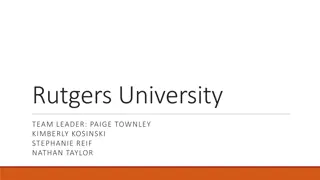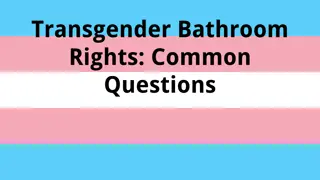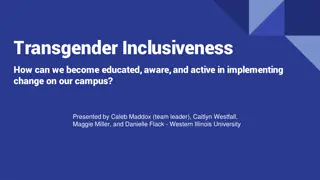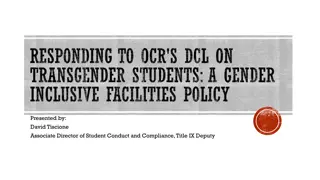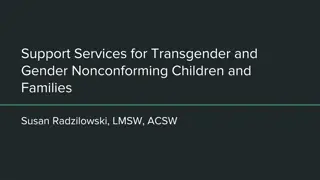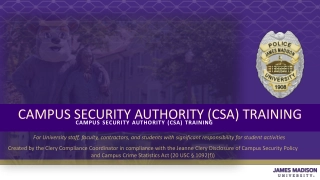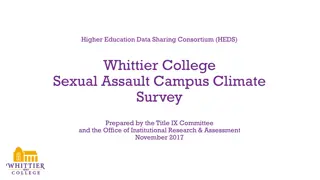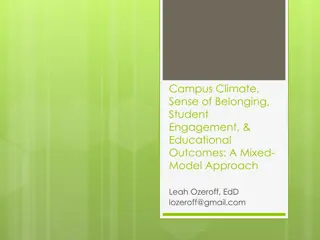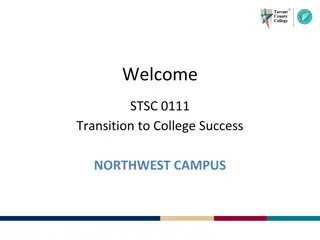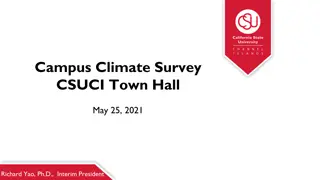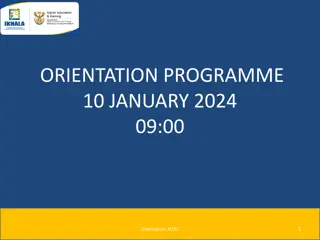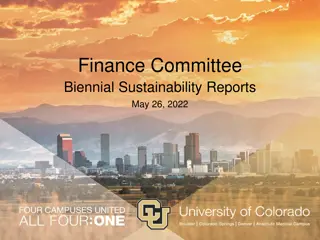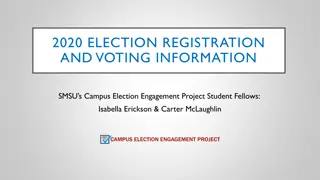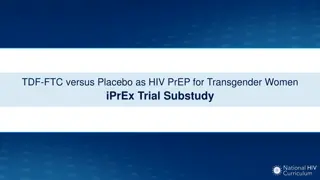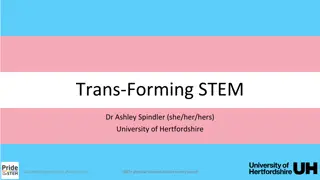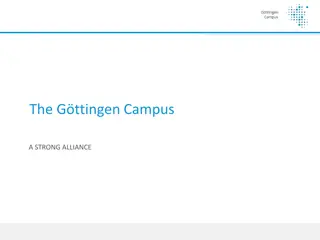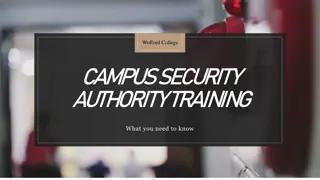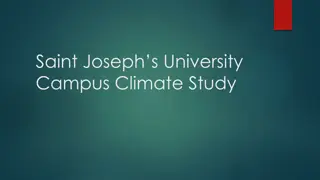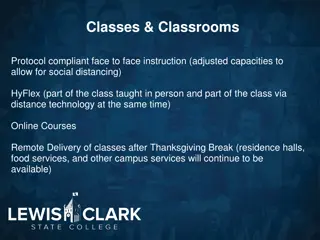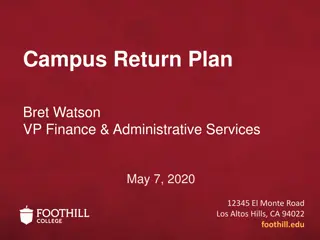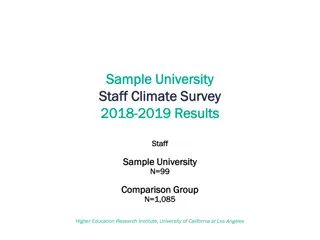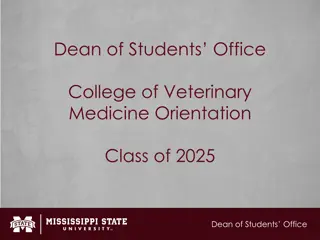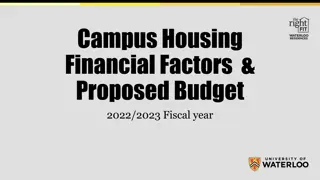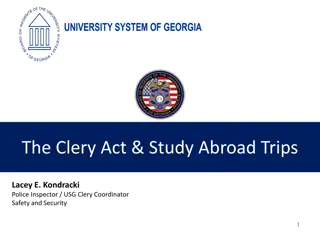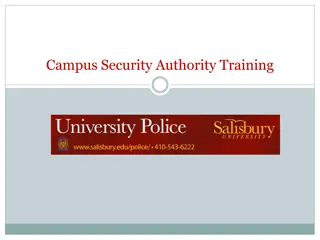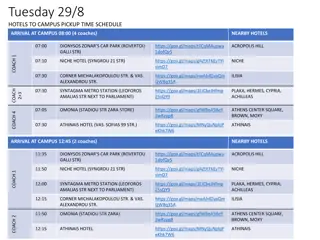Enhancing Campus Climate for Transgender Students at Centrist College
Explore the efforts of Centrist College in creating an inclusive environment for transgender students through team leadership, program evaluation, and student support initiatives. Learn about the college's mission, values, and commitment to diversity and student development. Discover the importance of fostering a safe and welcoming campus climate for all students, with a focus on marginalized gender identities.
Download Presentation

Please find below an Image/Link to download the presentation.
The content on the website is provided AS IS for your information and personal use only. It may not be sold, licensed, or shared on other websites without obtaining consent from the author. Download presentation by click this link. If you encounter any issues during the download, it is possible that the publisher has removed the file from their server.
E N D
Presentation Transcript
Stephanie Charles, Team Leader First year Master s student in Higher Education Administration, Graduate Assistant: Coordinator of Sitters for Service in the Graduate School Chelsea Primm, Supporting Team Member Second year Master s student in Higher Education Administration, Graduate Assistant: First Year Experience and Parent Programs Kiara Summerville, Supporting Team Member Second year Master s student in Higher Education Administration, Graduate Assistant: First Year Experience and Parent Programs Stephanie O Donnell, Supporting Team Member Second year Master s student Higher Education Administration and School Counseling, Graduate Assistant: Housing & Residential Communities, Community Director
Evaluation and Assessment of Centrist College s Programming for Transgender Students Professional Development Series Part 1
Meet the Team Stephanie Charles Director, Student Involvement Chelsea Primm Director, First Year Experience Kiara Summerville Director, Fraternity and Sorority Life Stephanie O Donnell Director, Housing and Residential Communities
Purpose, Task, & Importance of Meeting Purpose: To examine Centrist College s past, present, and future progress for improving overall campus climate among transgender students. Task: To create an inclusive campus environment for transgender students. Why is this important?: As recent institutions such as Yale University and the University of Missouri have faced public criticism for their lack of support for marginalized populations, Centrist College wants to be seen as an inclusive environment for all students with a heavy emphasis on marginalized gender identities, the forefront of which is transgender students.
About Centrist College Located in the heart of Albany, Georgia Approximately 8,000 of the best and brightest students from all fifty states Female population 64%, Male population 45%, Unspecified 1% Out-of-State students comprise 52%, In-State students comprise 48% Available on-campus housing for the majority of freshman and sophomore students with traditional and suite style housing options, as well as living learning communities (LLC) Mission & Values: Centrist College values collaboration, inclusivity, diversity, and the well- rounded, holistic development of students. Global citizenship, high achieving students, and leadership in and outside of the classroom are some of the university s top priorities.
Relevant Terms We believe in the benefit of explaining inclusive language in order to utilize terminology understood and accepted by the trans community. Gender Expression (noun) the external display of one s gender, through a combination of dress, demeanor, social behavior, and other factors, generally measured on scales of masculinity and femininity. Also referred to as gender presentation. Gender Identity (noun) the internal perception of an one s gender, and how they label themselves, based on how much they align or don t align with what they understand their options for gender to be. Common identity labels include man, woman, genderqueer, trans, and more. Generally confused with biological sex, or sex assigned at birth Trans*/Transgender (adj) (1) An umbrella term covering a range of identities that transgress socially defined gender norms. Trans with an * is often used to indicate that you are referring to the larger group nature of the term. (2) A person who lives as a member of a gender other than that expected based on anatomical sex. Passing (verb) (1) a term for trans* people being accepted as, or able to pass for, a member of their self-identified gender/sex identity (regardless of birth sex) without being identified as trans*. (2) An LGB/queer individual who is believed to be or perceived as straight. Transphobia (noun) the fear of, discrimination against, or hatred of trans* people, the trans* community, or gender ambiguity. Transphobia can be seen within the queer community, as well as in general society. Transphobia is often manifested in violent and deadly means. While the exact numbers and percentages aren t incredibly solid on this, it s safe to say that trans* people are far more likely than their cisgender peers (including LGB people) to be the victims of violent crimes and murder. Provided by: TheSafeZoneProject.com, Core Vocabulary 2.0
Transgender Identity Development Model Bilodeau s (2005) transgender identity development model provides six processes that show trans* students need safe spaces and safe interpersonal relationships (these can be either platonic or romantic) in order to develop their gender identity in a healthy and supportive way 1. Exiting a traditionally gendered identity [by] recognizing that one's gender variant, attaching a label to this identity, and affirming oneself as gender variant through coming out to others. 2. Developing a personal transgender identity [by] achieving the stability that comes from knowing oneself in relation to other transgender people and challenging internalized transphobia. 3. Developing a transgender social identity [by] creating a support network of people who know and accept that one is gender variant. 4. Becoming a transgender offspring [by] coming out as transgender to family members and reevaluating relationships that may be disrupted by this disclosure. 5. Developing a transgender intimacy status [by] creating intimate physical and emotional relationships. 6. Entering a transgender community [by] making a commitment to political and social action through challenging transphobia [and genderism].
Break Out Activity Break up into small groups of 3-4 and discuss what you think Centrist College is currently doing to improve the campus climate for transgender students. What did you discuss? Were there any obvious areas for improvement, any suggestions? Did you have trouble thinking of any initiatives or programs currently offered for this student population?
Areas to improve: Facility Inclusivity 1. Currently, there are no inclusive living options on campus. 2. The campus has no gender inclusive bathroom facilities. 3. The recreation facilities do not provide a gender inclusive locker room.
Areas to improve: Student Services 1. The Safe Zone department on campus mainly focuses on students and their sexual orientation. The department has little programming specifically for transgender students. 2. The Counseling Center offers individualized and group counseling sessions for all students, but no sessions are specific to trans* students. 3. Applications and records for the college do not have gender inclusive options or language.
Areas to Improve: Staff Training 1. There has been little training for professional counselors specifically for the trans* student population. 2. The Student Health Center needs to train their staff in the healthcare needs of trans* students.
What does the literature say about trans* students? Trans* students in high school usually experience victimization from their fellow students, which can lead to lower GPAs and a higher rate of absences. Despite this, many trans* students still intend to pursue a postsecondary education. (Aragon et al., 2014) As Weiss (2013) discusses, all people, including students, have a right to gender autonomy, meaning that they have the right to choose and express their own gender identity or identities. According to campus climate surveys at other institutions, transgender students often face higher rates of harassment than did men or women, feared revealing their gender identity, and considered leaving their university because of a chilly campus climate (Rankin et al., 2010). Due to their heightened potential for victimization and discrimination, transgender students face a large amount of stress. The Minority Stress Theory, which states that the increased stress faced by minority individuals leads to an increased level of psychological distress when individuals are unable to successfully increase their level of coping, can be applied to transgender students (Effrig et al., 2011, p. 144).
Action Plan: Moving Forward at Centrist College 1. Assess the current campus climate for trans* students and evaluate further changes identified as necessary a. A campus climate survey should also include questions about the climate within athletics and fraternity and sorority life; actions should be taken in order to make these departments more inclusive for trans* students. 2. Provide mandatory faculty workshops on knowledge of and available resources for trans* students and ways professors can be more inclusive in their pedagogical approach and overall curriculum 3. Provide monthly seminars for student affairs staff on inclusivity for students and the overall campus climate, specifically highlighting programs being established for the campus s trans* community (See proposed programs slide) 4. Create and acknowledge fluidity of gender in all campus records and documentation, including allowing for students easier access to updating their names and gender identities with the university
Action Plan Continued 5. Reevaluate residential halls and bathrooms across campus to provide an inclusive environment for all gender identities a. Housing and Residential Communities should reevaluate inclusive living options by providing all students the option to live in suite style residence halls, assuming all parties involved are agreeable and comfortable within their living situation. b. Future plans could include the implementation of a living-learning community for LGBTQ+ students (for example: UC Davis s The Rainbow House). 6. Collaborating with campus and community partners to provide educational, yet engaging programs for students on campus, targeting specific topics such as bullying, and other multicultural issues a. Higher administration should challenge and set forth a strategic plan for Safe Zone to explore further professional development opportunities for their staff when it comes to trans* issues a. The strategic plan should include the implementation of programming specifically for the trans* population and their allies b. Further programming should be implemented for educating faculty and staff as well as other students in the trans* community and the issues they may face
Proposed Programs for the Trans* Community Transgender Student Awareness Week in November A luncheon during the week for transgender and non-transgender students to interact and engage in healthy discourse about their experiences A seminar featuring a guest speaker who identifies as trans* Trans* 101 Learning Seminar for Faculty and Staff Members A mandatory training session for faculty and staff to learn from the lived experiences of trans* students and how to support trans* students in their pedagogical approach
References Aragon, S. R., Poteat, V. P., Espelage, D. L., & Koenig, B. W. (2014). The influence of peer victimization on educational outcomes for LGBTQ and non-LGBTQ high school students. Journal of LGBT youth, 11(1), 1-19. Beemyn, B. (2006). Ten Strategies to Improve Trans Inclusiveness on Campus. Best of the Best: An Official Queer Guide to Higher Education. Beemyn, B., Curtis, B., Davis, M., & Tubbs, N. J. (2005). Transgender issues on college campuses. New directions for student services, 111, 49-60. Bilodeau, B. L., & Renn, K. A. (2005). Analysis of LGBT identity development models and implications for practice. New Directions for Student Services,2005(111), 25-39. Buzuvis, E. (2013). On the Basis of Sex: Using Title IX to Protect Transgender Students from Discrimination in Education. Wis. JL Gender, & Soc'y, 28, 219. Effrig, J. C., Bieschke, K. J., & Locke, B. D. (2011). Examining victimization and psychological distress in transgender college students. Journal of College Counseling, 14(2), 143-157. Rankin, S., Weber, G., Blumenfeld, W., & Frazer, S. (2010). State of higher education for lesbian, gay, bisexual & transgender people. Charlotte, NC: Campus Pride. Seelman, K. L. (2014). Recommendations of transgender students, staff, and faculty in the USA for improving college campuses. Gender and education,26(6), 618-635. Weiss, J. T. (2013). Protecting transgender students: Application of Title IX to gender identity or expression and the constitutional right to gender autonomy. Wisconsin Journal Of Law, Gender & Society, 28(3), 331-346.



